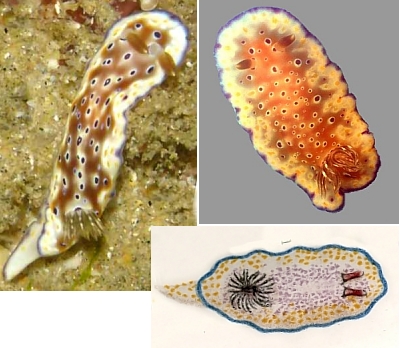Chromodoris tennentana and C. vicina
May 4, 2007
From: Bill Rudman

To accompany the many messages sent recently to the Forum about the variably coloured Chromodoris cavae, I though it worthwhile to summarise our understanding of C. tennentana, because one colour form of C. cavae, can easily be confused with C. tennentana.
Upper left: Sodwana Bay, South Africa, Indian Ocean. Length: 30 mm. 04 June 2005. Coral reef. Photographer: Colin Ogden [message #13967]. Upper right: Pangavini Is, Dar es Salaam, Tanzania, November 1976, 20 mm long alive. Photo: Bill Rudman. Lower right: Doris tennentana Kelaart, 1859. Kelaart's original painting of living animal published by Eliot (1906: Pl.XLIII fig. 1).
This species was first described Kelaart (1859) from Sri Lanka (Ceylon) as Doris tennentana. Kelaart was one of the first naturalists to describe tropical nudibranchs from the tropical Indian Ocean and although his description were brief, most have proven accurate enough, with the help of his published paintings, to identify his species. Although no mention is made of the orange-brown background, the distinctive colour of the gills and rhinophores can be seen in the painting, and the rhinophores are described as 'purplish red tipped with white. Also in the painting we can see a blue edge to the rhinophore pockets which are present in the photo of the Sth African specimen.
Doris tennentana Kelaart, 1859
"Mantle white with a faint bluish shade and spengles with golden-coloured and purple spots. margin caerulean blue. Dorsal tentacles clavate, purplish red, tipped with white, laminate. barchial plumes red, numerous, 12 to 15, linear, bipinnated. Foot white, upper surface spotted with yellow .... Under surface of mantle white, with bluish reflexions"
Charles Eliot (1904) described both Chromodoris vicina and C. cavae, but unfortunately the description of C. vicina was not accompanied by a colour illustration. However the description of the living animal is quite adequate for identification and matches both the photos from South Africa and Tanzania. Of particular interest is Eliot's mention of a white spot in some of the larger dark spots on the mantle, which can be seen in the upper left photo. Edmunds (1971) reported this species again from east Africa as Chromodoris vicina.
Chromodoris vicina Eliot 1904
Twelve specimens from Chuaka, Zanzibar - colour note of living animals:
"Mantle and foot bordered with light violet, the latter border a row of dots. Middle of back drab brown with bright violet spots, the larger ones with a white centre. Near the edge of the mantle a number of yellow spots with white borders, which are often confluent. The foot deep and narrow, white with some yellow spots near the lower edge. The rhinophores dark brown with white tips. Each of the branchiae bore two black bands"
In a earlier publication (Rudman, 1987) I considered that Chromodoris cavae Eliot, 1904, was also a synonym of C. tennentana, but numerous photos on the Forum of C. cavae show that it is a distinct species.
In brief, C. tennentana is a translucent creamy white with a mottled orange to brownish patch covering the central part of the mantle. On the brownish patch are scattered dark purple spots of variable size, some of which have a central white spot. Each purple spot is ringed with white. Between the brownish patch and the mantle edge are scattered yellow spots which can also be ringed with white. There is a watery purple band around the mantle edge, with some darker patches arranged evenly around the edge, and extending into the creamy white of the outer mantle. The sides of the body and foot are also creamy white with some large purple spots, ringed with white, on the sides of the body and smaller yellow spots near the edge of the foot. The foot is edged with watery purple band which can be broken into a series of spots.
There are many species with purple or purple and yellow spots, some of which I have discussed as the 'Risbecia tryoni colour group' and others as the C. aureopurpurea group. Of particular interest to any discussion of C. tennentana is the Indo-West Pacific species C. collingwoodi which has colour forms which are very similar, suggesting it is almost certainly a geographic sister species.
-
Edmunds, M. (1971) Opisthobranchiate Mollusca from Tanzania (Sub-Order: Doridacea. Zoological Journal of the Linnean Society, 50: 339-396.
-
Eliot, C.N.E. (1904) On some nudibranchs from East Africa and Zanzibar. Part IV. Proceedings of the Zoological Society of London, (1904): 380-406.
-
Eliot, C.N.E. (1906): On the nudibranchs of Southern India and Ceylon, with special reference to the drawings by Kelaart and the collections belonging to Alder & Hancock preserved in the Hancock Museum at Newcastle-on-Tyne. Proceedings of the Zoological Society of London for 1906, 2, 636-691. (Pls. 42-47)
-
Eliot, C.N.E. (1906) On the nudibranchs of Southern India and Ceylon, with special reference to the drawings by Kelaart and the collections belonging to Alder and Hancock, preserved in the Hancock Museum at Newcastle-on-Tyne, No. 2. Proceedings of the Zoological Society of London for 1906, 999-1008.
-
Kelaart, E.F. (1859) On some additional species of nudibranchiate Mollusks from Ceylon. Annals & Magazine of Natural History, IV: 267-270.
-
Rudman, W.B. (1984) The Chromodorididae (Opisthobranchia: Mollusca) of the Indo-West Pacific: a review of the genera. Zoological Journal of the Linnean Society 81: 115-273.
-
Rudman, W.B. (1987) The Chromodorididae (Opisthobranchia: Mollusca) of the Indo-West Pacific: Chromodoris epicuria, C. aureopurpurea, C. annulata, C. coi and Risbecia tryoni colour groups. Zoological Journal of the Linnean Society 90: 305-407.
-
Rudman, W.B. (1987) The Chromodorididae (Opisthobranchia: Mollusca) of the Indo-West Pacific: Chromodoris epicuria, C. aureopurpurea, C. annulata, C. coi and Risbecia tryoni colour groups. Zoological Journal of the Linnean Society, 90: 305-407.
Related messages
-
Chromodoris tennentana from South Africa
From: Colin Ogden, May 4, 2007 -
Real Chromodoris tennentana from Sth Africa
From: Valda Fraser, November 13, 1999
